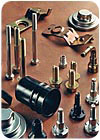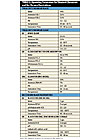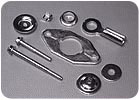
Zinc alloys with different passivations.
Cadmium plating was once widely used by the automotive and marine industries for its superior corrosion protection and lubricity. However, cadmium is a heavy metal, and the cyanide bath commonly used to produce cadmium deposits is highly toxic. For these reasons, The European Union End of Life Vehicle Directive (ELV) banned the use of cadmium and other heavy metals in the automotive industry in fall 2000, and additional environmental initiatives in Europe and the U.S. have limited the use of cadmium plating in other applications. Alternatives to cadmium have been investigated, but cadmium offers some unique characteristics that cannot be obtained with other materials.
While it has not been possible to phase out cadmium deposits completely in the aerospace, marine and nuclear industries, researchers have developed less toxic, noncyanide cadmium plating systems. New zinc-alloy systems and post-treatment processes also hold promise as a means to reduce cadmium plating without compromising on performance.
Alternative Cadmium Plating Baths
Two alternative cadmium plating baths - one based on sulfuric acid and the other a neutral-pH formulation - offer a less toxic alternative to traditional cyanide baths.Acid cadmium plating baths are currently in large-scale industrial use. The electrolyte is composed of 3 to 5% sulfuric acid and 3 to 6 oz/gal of cadmium. The system uses two additives: a grain refiner and a brightener. In applications where aesthetics are not an issue, a smooth, uniform, functional deposit can be obtained without using the brightener, therefore lowering the risk of hydrogen embrittlement.
The neutral-pH cadmium bath is a Boeing-approved process that plates cadmium from a nearly neutral pH electrolyte. The electrolyte contains 12 to 16 oz/gal of ammonium sulfate, nearly 1 oz/gal of ammonium chloride and 1 oz/gal of cadmium. The pH of the solution is adjusted to 6.5 with ammonium hydroxide or sulfuric acid. In addition to the anode corrosion agent, this process uses two additives. The deposit from the bath is smooth and level and has an excellent throw in low-current areas. The deposit readily accepts post-treatments to further enhance corrosion protection.

Table 1.
Zinc Alloys
New zinc-alloy systems (such as zinc-iron, zinc-cobalt and zinc-nickel) can provide a high-performance, corrosion-resistant alternative to cadmium plating. Like zinc, these alloys provide sacrificial protection to steel parts. However, their rate of corrosion is less than zinc alone because of the presence of more noble metals in the deposit.1Zinc-Iron/Zinc-Cobalt.Some of the newer zinc-iron and zinc-cobalt alloy systems are based on an alkaline zinc plating bath with additions of iron or cobalt complexes. The amounts of iron or cobalt in the alloy deposits vary from 0.4 to 0.8%. Without a hexachrome passivation, there is not much difference in the protection provided by zinc alone or by zinc-iron or zinc-cobalt. However, with a chromate conversion coating treatment, the protection offered by the zinc-iron and zinc-cobalt can be two to three times higher than zinc.
Another zinc-cobalt process, an acid, is based on a potassium chloride or mixed salt containing electrolyte, and it operates at a pH between 5 and 5.5. Cobalt is added as a chloride salt, and the zinc-to-cobalt ratio in the electrolyte is kept between 8 and 10. The process uses two additives - a zinc cobalt carrier and zinc cobalt replenisher - to give a zinc-cobalt deposit with 0.3 to 0.8% cobalt. The bath has more than 95% plating efficiency, so it works well for barrel plating smaller parts.
Since both the alkaline and acid zinc-cobalt processes use a limited number of additives, both systems are easy to run and control. The deposit from both systems is bright and has consistent alloy ratios.
Zinc-Nickel.Electroplated zinc with a post-treatment in chromate conversion coatings had been the unchallenged workhorse as a functional coating in automotive, construction and other industries. However, as the ELV and other environmental initiatives have phased out the use of hexavalent chromium along with cadmium, metal finishers have had to search for an alternative. Without a chromate conversion coating, electroplated zinc shows a heavy white corrosion in just a few hours of exposure to the neutral salt spray test. A 0.3-mil-thick zinc electrodeposit can develop red rust in less than 72 hours in a salt spray atmosphere. Conversion coatings without hexavalent chromium are available to give better salt spray results over electroplated zinc, but they lack hexavalent chromium’s self-healing property and are more expensive to use.
Zinc-nickel alloy plating with 10 to 14% nickel in the deposit provides a corrosion-resistant solution. Boeing Corp. developed an acid zinc-nickel plating process in 1992 as an alternative to cadmium plating in aerospace applications.2Since then, zinc-nickel technology has become increasingly popular in other industries.
Even without a conversion coating, zinc-nickel deposits at 0.3 mil thick give more than 500 hours of neutral salt spray protection against the appearance of red rust. A slight white product appears on the deposit within the first 24 hours of neutral salt spray exposure; however, unlike zinc deposits, the zinc-nickel retains a nonvoluminous white blush without causing any dimensional changes in the parts. This property makes zinc-nickel plating a better choice for the fastener industry.
The use of a high-performance nonhexachrome clear passivation can further increase protection against red rust to more than 1,000 hours in the neutral salt spray test. The operating parameters of a widely used, GM-4700-approved acid zinc-nickel plating process are given in Table 1. The deposit from this acid zinc-nickel process is bright and ductile with good leveling. The acid process also offers a plating efficiency of more than 95%, compared to the average efficiency of 50% for alkaline zinc-nickel plating processes.
Because of its high efficiency, the deposit from the acid zinc-nickel plating process has little tendency toward hydrogen embrittlement. The structure of the deposit is open-grained and smooth, permitting any trapped hydrogen to bake out.3
One of the most striking features of the zinc-nickel deposit with 10 to 14% nickel is its excellent corrosion protection against the appearance of red rust, even without a post treatment. This feature makes the zinc-nickel plating process more acceptable than any other zinc alloy process.
Unlike zinc-iron and zinc-cobalt, zinc-nickel deposits can provide a significant increase in protection compared to zinc alone without the use of chromate conversion coatings. The acid zinc-nickel plating bath uses only two additives compared to the alkaline zinc-nickel bath, which uses four or more additives and is difficult to control.
Tin-Zinc.Tin-zinc alloy plating is another environmentally friendly functional plating process. Based on a nearly neutral pH bath, the deposit from the tin-zinc plating process contains around 30% zinc, while the remainder is tin. The bath is stable and remains clear over time. A 0.3-mil-thick tin-zinc deposit can give salt spray protection of more than 600 hours even without a post-treatment. When treated with an appropriate conversion coating, the deposit gives more than 1,000 hours of protection.

Table 2.
Environmentally Friendly Post-Treatments
Researchers also have developed a number of post-treatments for zinc and zinc alloys based on trivalent chromium and chrome-free chemistries.Black for Zinc/Zinc Alloys.A trivalent black passivation for zinc, zinc-iron and zinc-cobalt deposits produces a good black coating in about 20 to 50 seconds and is applied at room temperature. The treatment is based on two additives, which are used at 3 to 4% and 5 to 6% levels, respectively. The protection of the coating can be enhanced by using an appropriate topcoat.
Clear for Zinc/Zinc Alloys.Two new processes based on trivalent chromium give a clear coating over zinc, zinc-iron and zinc-cobalt deposits. One of these is a conventional clear coating with a minimum salt spray protection, while the other provides moderate protection and is best for the subsequent absorption of different dyes.
Clear for Zinc-Nickel.A clear passivation for zinc-nickel deposits, used at 5% by volume in water, can provide more than 1,000 hours of salt spray protection against the appearance of red rust.
No-Chrome Black for Zinc/Zinc Alloys.Two chrome-free powder formulations provide black coatings over zinc-nickel and zinc, zinc-iron and zinc-cobalt. These coatings are used at 3 oz/gal and work at 160 to 170°F (71 to 77°C). The working parameters of these passivations are given in Table 2.

Zinc-nickel plated parts with a clear chromate.
Continued Research
Technology advances such as noncyanide cadmium plating baths, zinc-alloy plating processes and environmentally friendly post-treatments are helping metal finishers meet current regulations without sacrificing performance. As cadmium and other heavy metals become even more tightly regulated in the coming years, researchers will continue to investigate alternatives that will provide high levels of corrosion protection with more environmentally sustainable materials and processes.For more information, visit www.aldoaco.com.

Report Abusive Comment